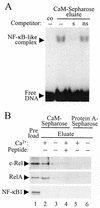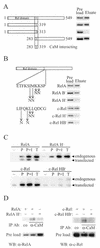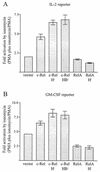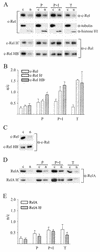Regulation of c-Rel nuclear localization by binding of Ca2+/calmodulin
- PMID: 12556500
- PMCID: PMC141150
- DOI: 10.1128/MCB.23.4.1418-1427.2003
Regulation of c-Rel nuclear localization by binding of Ca2+/calmodulin
Abstract
The NF-kappa B/Rel family of transcription factors participates in the control of a wide array of genes, including genes involved in embryonic development and regulation of immune, inflammation, and stress responses. In most cells, inhibitory I kappa B proteins sequester NF-kappa B/Rel in the cytoplasm. Cellular stimulation results in the degradation of I kappa B and modification of NF-kappa B/Rel proteins, allowing NF-kappa B/Rel to translocate to the nucleus and act on its target genes. Calmodulin (CaM) is a highly conserved, ubiquitously expressed Ca(2+) binding protein that serves as a key mediator of intracellular Ca(2+) signals. Here we report that two members of the NF-kappa B/Rel family, c-Rel and RelA, interact directly with Ca(2+)-loaded CaM. The interaction with CaM is greatly enhanced by cell stimulation, and this enhancement is blocked by addition of I kappa B. c-Rel and RelA interact with CaM through a similar sequence near the nuclear localization signal. Compared to the wild-type protein, CaM binding-deficient mutants of c-Rel exhibit increases in both nuclear accumulation and transcriptional activity on the interleukin 2 and granulocyte macrophage colony-stimulating factor promoters in the presence of a Ca(2+) signal. Conversely, for RelA neither nuclear accumulation nor transcriptional activity on these promoters is increased by mutation of the sequence interacting with CaM. Our results suggest that CaM binds c-Rel and RelA after their release from I kappa B and can inhibit nuclear import of c-Rel while letting RelA translocate to the nucleus and act on its target genes. CaM can therefore differentially regulate the activation of NF-kappa B/Rel proteins following stimulation.
Figures







Similar articles
-
RelA is a potent transcriptional activator of the CD28 response element within the interleukin 2 promoter.Mol Cell Biol. 1995 Aug;15(8):4260-71. doi: 10.1128/MCB.15.8.4260. Mol Cell Biol. 1995. PMID: 7623820 Free PMC article.
-
Depletion of c-Rel from cytokine gene promoters is required for chromatin reassembly and termination of gene responses to T cell activation.PLoS One. 2012;7(7):e41734. doi: 10.1371/journal.pone.0041734. Epub 2012 Jul 30. PLoS One. 2012. PMID: 22860011 Free PMC article.
-
Tumor necrosis factor-alpha activation of NF-kappa B requires the phosphorylation of Ser-471 in the transactivation domain of c-Rel.J Biol Chem. 2000 Aug 11;275(32):24383-91. doi: 10.1074/jbc.M909396199. J Biol Chem. 2000. PMID: 10823840
-
[The Rel/NF-kappa-B transcription factors: complex role in cell regulation].Pathol Biol (Paris). 2002 Apr;50(3):204-11. doi: 10.1016/s0369-8114(02)00289-4. Pathol Biol (Paris). 2002. PMID: 11980335 Review. French.
-
The Transcription Factor NF-κB in Stem Cells and Development.Cells. 2021 Aug 10;10(8):2042. doi: 10.3390/cells10082042. Cells. 2021. PMID: 34440811 Free PMC article. Review.
Cited by
-
Nesprin-2 mediated nuclear trafficking and its clinical implications.Nucleus. 2015;6(6):479-89. doi: 10.1080/19491034.2015.1128608. Epub 2015 Dec 8. Nucleus. 2015. PMID: 26645154 Free PMC article.
-
Specific nuclear localizing sequence directs two myosin isoforms to the cell nucleus in calmodulin-sensitive manner.PLoS One. 2012;7(1):e30529. doi: 10.1371/journal.pone.0030529. Epub 2012 Jan 25. PLoS One. 2012. PMID: 22295092 Free PMC article.
-
STIM- and Orai-mediated calcium entry controls NF-κB activity and function in lymphocytes.Cell Calcium. 2018 Sep;74:131-143. doi: 10.1016/j.ceca.2018.07.003. Epub 2018 Jul 10. Cell Calcium. 2018. PMID: 30048879 Free PMC article. Review.
-
Differential cytokine regulation by NF-kappaB and AP-1 in Jurkat T-cells.BMC Immunol. 2010 May 27;11:26. doi: 10.1186/1471-2172-11-26. BMC Immunol. 2010. PMID: 20507572 Free PMC article.
-
Lipopolysaccharide induces endoplasmic store Ca2+-dependent inflammatory responses in lung microvessels.PLoS One. 2013 May 10;8(5):e63465. doi: 10.1371/journal.pone.0063465. Print 2013. PLoS One. 2013. PMID: 23675486 Free PMC article.
References
-
- Arenzana Seisdedos, F., P. Turpin, M. Rodriguez, D. Thomas, R. T. Hay, J. L. Virelizier, and C. Dargemont. 1997. Nuclear localization of I kappa B alpha promotes active transport of NF-kappa B from the nucleus to the cytoplasm. J. Cell Sci. 110:369-378. - PubMed
-
- Barkett, M., and T. D. Gilmore. 1999. Control of apoptosis by Rel/NF-kappaB transcription factors. Oncogene 18:6910-6924. - PubMed
-
- Bird, T. A., K. Schooley, S. K. Dower, H. Hagen, and G. D. Virca. 1997. Activation of nuclear transcription factor NF-kappaB by interleukin-1 is accompanied by casein kinase II-mediated phosphorylation of the p65 subunit. J. Biol. Chem. 272:32606-32612. - PubMed
-
- Capobianco, A. J., D. L. Simmons, and T. D. Gilmore. 1990. Cloning and expression of a chicken c-rel cDNA: unlike p59v-rel, p68c-rel is a cytoplasmic protein in chicken embryo fibroblasts. Oncogene 5:257-265. - PubMed
Publication types
MeSH terms
Substances
LinkOut - more resources
Full Text Sources
Molecular Biology Databases
Miscellaneous
